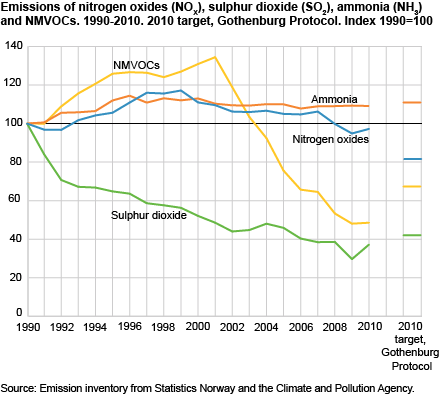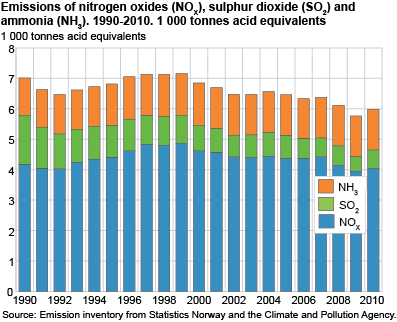Content
Published:
This is an archived release.
Norway failed to achieve NOx obligations
The emission of acidifying and polluting nitrogen oxides (NOx) in 2010 ended 19 per cent above Norway’s obligation set in the Gothenburg Protocol. Sulphur dioxide (SO2) and ammonia (NH3) emissions, which are also acidifying gases, ended within the target.
The emission obligation for non-methane volatile organic carbon (NMVOC) was already reached in 2006, and in 2010 the emission was 28 per cent below the target. The Gothenburg Protocol from 19991 sets a ceiling for Norway’s national emissions of gases contributing to acidification, eutrophication and formation of near-ground ozone. The obligations apply to 2010, and the reference year is 1990.
In 2010 the activity in the manufacturing industries increased, from a low level in 2009. Higher production of iron, steel and ferroalloys thus resulted in increased emissions of acidifying gases this year. Higher production of gas power and district heating also contributed to the increase.
The Norwegian emission inventory is compiled by Statistics Norway in collaboration with the Climate and Pollution Agency. The new figures include breakdowns by source and industry, and principally confirm the preliminary figures from May last year (see box).
| Gas |
Emissions
1990 |
Emissions
2010 |
Emission ceiling
2010 |
Fulfilment
(per cent above or below ceiling) |
Harmful effects | ||||||||||||||||||||||||||||||||||||||||||||||||||||||||||||||||||||||||||
|---|---|---|---|---|---|---|---|---|---|---|---|---|---|---|---|---|---|---|---|---|---|---|---|---|---|---|---|---|---|---|---|---|---|---|---|---|---|---|---|---|---|---|---|---|---|---|---|---|---|---|---|---|---|---|---|---|---|---|---|---|---|---|---|---|---|---|---|---|---|---|---|---|---|---|---|---|---|---|---|
| Nitrogen oxides (NOX) | 191 | 186 | 156 | -19 | Increase the risk of respiratory disease (particularly NO2). Contribute to acidification, corrosion, formation of ground-level ozone and eutrophication | ||||||||||||||||||||||||||||||||||||||||||||||||||||||||||||||||||||||||||
| Sulphur dioxide (SO2) | 52 | 19 | 22 | 12 | Increases the risk of respiratory complaints. Contributes to acidification of water and soils, and causes corrosion | ||||||||||||||||||||||||||||||||||||||||||||||||||||||||||||||||||||||||||
| Ammonia (NH3) | 21 | 23 | 23 | 1 | Contributes to acidification of water and soils, and eutrophication | ||||||||||||||||||||||||||||||||||||||||||||||||||||||||||||||||||||||||||
| NMVOCs | 290 | 141 | 195 | 28 | May include carcinogenic substances. Contribute to formation of ground-level ozone | ||||||||||||||||||||||||||||||||||||||||||||||||||||||||||||||||||||||||||
| CO | 747 | 334 | - |
No quantified
emission ceiling |
Increases risk of heart problems in people with cardiovascular diseases | ||||||||||||||||||||||||||||||||||||||||||||||||||||||||||||||||||||||||||
| Source: Emission inventory from Statistics Norway and the Climate and Pollution Agency. |
NOx emission reduced, but still well above target2
The Norwegian NOx emission reached 185 900 tonnes in 2010, which is 19 per cent above the Gothenburg Protocol ceiling of 156 000 tonnes. The emission was 4 500 tonnes, or 2 per cent, higher than the previous year. Higher activity within manufacturing of iron, steel and ferroalloys and higher construction activity are the main causes.
The 2010 emission was 3 per cent below the 1990 level. From 1990 to 1999, the emission increased considerably and reached a historical peak of 224 000 tonnes. After this 1999 peak, the emission dropped by 17 per cent to reach the 2010 level.
Domestic sea transport and fishing accounted for 28 per cent of the total Norwegian NOx emission in 2010. In 2008, the emission from ships and boats dropped by as much as 13 per cent, but has remained stable since then. Increased fuel use by fishing vessels has offset the reductions due to technical efforts in this sector.
Stationary combustion in oil and gas-related activities contributed with 27 per cent, and road traffic with 20 per cent of the NOx emissions. Manufacturing and construction made up the principal part of the remaining quarter. The last three years have shown a decline in the NOx emissions from road traffic, due to new cleaning technologies for exhaust from heavy duty diesel vehicles and a generally newer car fleet. However, the emissions from diesel fired engines used within oil extraction increased during the latter years and curbed the overall reduction in NOx emissions.
The NOx fund was established in 2008 as an instrument for financing abatement measures for NOx in industry. According to information given by the fund, measures were implemented during the period 2006-2010 that gave verified reductions of approximately212 000 tonnes in 2010. A total of 1 000 tonnes of reductions that have not yet been verified were also reported. Without these reductions, the NOx emissions in 2010 would have been about 6-7 per cent2 higher.
SO2 emission well below target
The 2010 emission of SO2 ended 12 per cent below the ceiling of 22 000 tonnes according to the Gothenburg Protocol, despite a 26 per cent increase from the previous year. The long-term trend has nevertheless been a decrease. The main part of the reduction appeared before 1993, which was a consequence of lower sulphur content in oil products and measures and closures within manufacturing and mining.
Manufacturing, mining and quarrying account for 68 per cent of the current SO2 emissions, and the increase in 2010 is mainly due to higher production in these industries, following the low activity in 2009.
Steady NH3 emissions just below target
The overall NH3 emission changed marginally in 2010, and the level has been fairly constant since 1980. The 2010 emission was just below the ceiling of 23 000 tonnes according to the Gothenburg Protocol. The share from agriculture makes up 90 per cent, of which the bulk is from manure. The emissions from manure and ammonia treatment of straw increased slightly, while emissions from the use of inorganic fertilizers dropped by 18 per cent in 2010. This was due to new fertilizers giving a lower NH3 loss. NH3 is an alkaline gas, but is transformed into acid in the soil by bacteria and hence contributes to acidification.
NMVOC emissions down, CO emissions slightly up
In 2010, the NMVOC emissions increased by one per cent to 141 000 tonnes, after a substantial decline from 2001. Improved loading technology in the oil industry in the last 10 years has contributed to the decline, and this trend continued in 2010. However, the emission of solvents from products increased steeply in 2010, after a drop in the previous year, and made up for the decline in the oil industry. The NMVOC emission still ended 28 per cent below the Gothenburg Protocol target.
The 2010 CO emission was four per cent below the 2009 level. However, the long-term trend since 1990 is a 55 per cent fall, almost entirely due to a huge drop in CO emissions from petrol cars. Today, heating in households and use of private cars, motor bikes and other light duty vehicles account for 2/3 of the emissions. Norway has no obligations concerning the emission of CO.
Total acidifying emission is still high
Gases that transform into different amounts of acid can be expressed as total acidifying emission in terms of acid equivalents . Total acidifying emission of the three gases NOx, SO2 and NH3 rose by 4 per cent from 2009 to 2010. The emission in 2010 was 10 per cent above the targets in the Gothenburg Protocol (see table) when these are recalculated into acid equivalents. Since 1990, the total acidifying emission has been reduced by 15 per cent. Up to the peak in 1999, the SO2 dropped, while the NOx emission rose significantly. Since 1999, the total acidifying emission has dropped by 16 per cent.
Back in 1980, SO2 was the dominant acidifying gas, in terms of acid equivalents. This share is now reduced to just 10 per cent, while NOx accounts for 68 per cent and NH3 accounts for 22 per cent.
Changes from preliminary 2010 figures, released in May 2010The new figures on emissions of SO2, CO and NMVOC in 2010 are eight, five and four per cent above the preliminary figures from May 2011 respectively. The new figures on emissions of NOx and NH3 are one per cent below the preliminary figures. The main changes concern the emissions of SO2(upwards adjustment) and NOx(downwards adjustment) from coastal sea traffic, NMVOC from solvents (upwards adjustment) and CO from heating of households (upwards adjustment). The changes are routine, due to updated input data. |
About the emission inventory
Read more about:
- The Norwegian Emission Inventory. Documentation of methodologies for estimating emissions of greenhouse gases and long-range transboundary air pollutants (Documents 2010/21)
- The state of the environment in Norway
See also emission figures for hazardous substances published today. Revised emission figures for greenhouse gases will be published on Monday 13 February 2012. See also the article on National Accounts and environment, with reference to greenhouse gases, published the same day.
| 2Corrected 10 February 2012. |
Tables:
The statistics is published with Emissions to air.
Contact
-
Statistics Norway's Information Centre
E-mail: informasjon@ssb.no
tel.: (+47) 21 09 46 42


